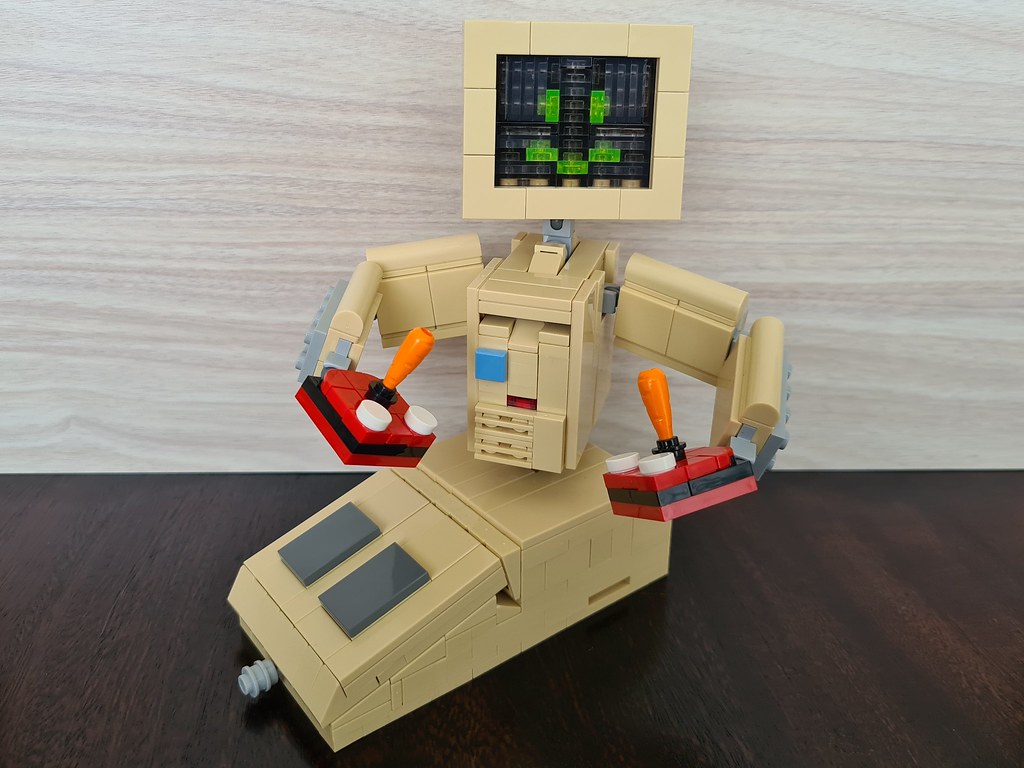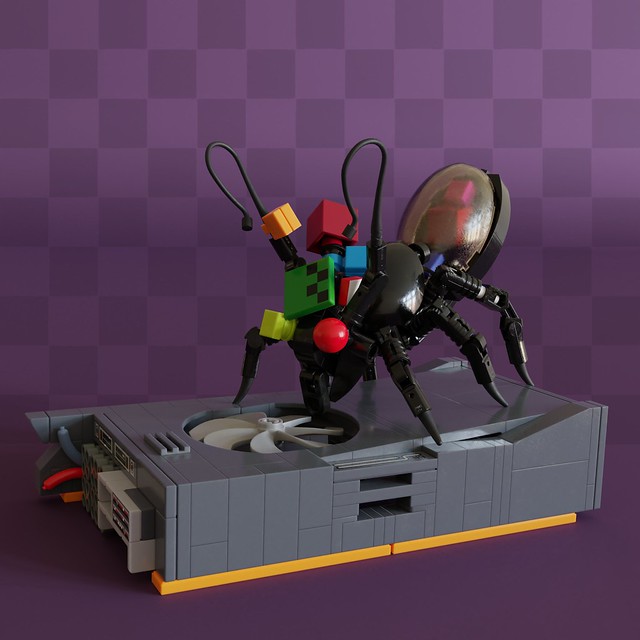Keep your Siri, Alexa, and chatGPT powered agents. There’s only one digital assistant for me, and he lives exclusively in Microsoft products between 1997-2003… and in hour hearts. And now in LEGO thanks to Piotr Gierwatowski! Assembled from just a few dozen bricks, LEGO Clippy is just as adept as his digital inspiration at recognizing when you want to write a letter. Better yet, LEGO Clippy is never afraid to voice wrong-headed guesses about which pieces you might want to include in your next creation.
Tag Archives: Computers
Don’t bug me with your PC problems!
There’s two things I love in this world: great LEGO builds, and word-play. Philippe Moisan‘s latest build has both in spades! You might think it looks like an insect’s apartment – but in fact, this is a computer. Don’t believe me? Well for starters, there’s a literal computer – i.e. an object to compute or calculate – in form of an abacus. There’s a bunch of hard discs on the walls; a deck of (expansion) cards on the shelves; a mother (surf) board; some (integrated) chips; and of course the fan. But front and centre of it all is a problem. This PC’s got a bug! But as long as they still let you access The Brothers Brick, I think we can let them stay…
Hey, Mac! Care for a game?
Straight from the 1970’s, Jason Cichon provides us a LEGO-built gaming machine with a bit of extra character. I’m immediately transported back to my grandpa’s basement, playing games via 8″ floppy on his revived IBM. The standard tan casing I remember is brought back here in this build, now sculpted into an anthropomorphic visage complete with an 8-bit face. I love the plate work used in the monitor’s simple smile, and the washed out baby blue panel on the body of the computer-bot. But the highlights for me are the bright joystick hands on this retro gaming steward. The red and orange color palette feels perfect for the products of the age, and the use of carrot parts for the sticks themselves is inspired. Now, if you’ll excuse me, they need me back on the Oregon Trail.
The circuit of life is a series of parallels
One of the great pleasures I find in creating art through LEGO bricks is the ability to merge two contrasting forces. It could be two colors in something as simple as a black and white build. Or it could be the complexity of a mature emotion like grief or loss expressed via a toy for children. In this case, Ralf Langer highlights the natural and the artificial in this computer board/forest hybrid. And, boy, does Ralf show off his prowess for both styles. The circuitry is sharp, precise, and clean; all stud-less with crisp corners and neat rows. Gradually, that regimented look gives way on the green medium to Nature’s chaos: curves, bumps, and rocky nodes galore! There’s a lot of great parts usage here, but my favorite has got to be the dual rows of Modulex bricks. These LEGO products of a slightly different scale are a rare sight in builds, but can provide some truly brilliant solutions to construction problems without straying from the brand.
An upgrade every computer should have.
When a program on your PC stops responding, there’s only one hero who can save the day: The Task Manager. Ivan Martynov has personified the Task Manager in battle against a monstrous glitch in this fantastic Bio-Cup entry. The scene works especially well thanks to a terrific trio of pop-up browser windows, which the bug is crawling through. The full build is an action-packed reminder to save your work often.
21st century man
Just on the border of your waking mind, there lies another time, where darkness and light are one. This LEGO computer figure by Sandro Quattrini fits right into 1981 sci-fi. He’s probably got an IQ of 1001. This build is so full of great techniques and part usages and the poses it’s capable of achieving are wonderful! Some of the more interesting techniques used are the handcuffs used to replicate laces on the boots and the dots line bracelet used here as a belt. The star of the show would have to be the amazing zippered jacket using an ice skate as the zipper pull and roller skates for each side. The classic-styled computer head is phenomenal and really provides a ton of character and life to this build.
Check out more facial expressions and poses below!
This Agat-4 sure is a brick
Personally, I’m a bit of a caveman when it comes to technology. Working with computers sometimes feels like interacting with a magic tablet controlled by a temperamental spirit that doesn’t like me. While I shudder at the idea of diving into code, I have friends that program games on old computers for fun. Understanding the finer details of the process might not be my strong suit but it’s easy to appreciate the process and results of their efforts. Especially when those friends often build their own computers as well. So I can’t help but think of them when I see a model like this. Builder David Strenzler, otherwise known as Force of Bricks, has built a LEGO version of a Soviet computer from the era of the Apple II and the Commodore 64. Let’s take a look at this beautiful model of the Agat 4 8-bit computer.
A different sort of digital LEGO build
These days, we come across a lot of digital LEGO builds, and it’s easy to see why. Through several free programs, the world of virtual building offers anyone access to infinite quantities of bricks in any type and color you need. But despite having seen thousands of digital creations, builder Tong Xin Jun still managed to create something I’ve never before seen: LEGO Digital Designer. The interface of LEGO’s now-retired free building software will be familiar to many of you, but look closely, because I promise you’ve never seen it like this before. That’s right, this is the LDD interface built out of bricks within LDD! It’s an absolutely brilliant piece of design that I’d love to see rendered with physical bricks, and I actually think the majority of it could be.
Welcome to Circuit City
Have you ever looked at a circuit board and thought it looked a little like a futuristic cityscape? LEGO builder Adam Betts has run with that idea for this awesome microscale city, which he says is based on the idea that cities, like circuit boards, are highly interconnected and optimized for efficiency. Look closely and you’ll see that the left side of the city starts out with ambiguous structures that mimic circuitry, but then slowly move into more recognizable skyscrapers to the right, complete with a zeppelin and bustling seaport. Or is it a serial port?
Man, this thing is seriously buggy
If you spend any time working on a computer, and let’s face it, we all spend more time on computers than usual these days, you’ve probably experienced the occasional glitch with your graphics card. I think that Ivan Martynov may have discovered the real cause of all those graphic glitches. This dark and colorful critter is snacking on a graphic card, and by the look of it, he’s going to do some damage. Aside from the many printed tiles used on the computer module, I love the use of a Creeper face from the Minecraft theme.
Once upon a time 4.77MHz is all you needed to get things done
Getting everything done was possible on an IBM PC XT running at 4.77 MHz not too long ago. Yes, you read that right, all gaming needs, word-processing needs, and multiplayer games meant your sibling or friend sitting right beside you banging on that other side of the keyboard and functioning at the amazing single-digit MHz. This digital render by mrmotinjo is a time machine back to the ’80s.
While you continue to admire the rest of the peripheral devices like speakers and joysticks take a closer look at the elegant desk, which is also built with digital bricks. And believe me when I say those 2×2 tiles are a lot more reliable and lasting than what we used to call our storage devices – floppy disks. Now all I need to find is that turbo button that will get my machine screaming up to 8MHz.
The Future: 1972
The average person now carries more computing power in their pocket than what it took to put the Apollo 11 astronauts on the moon. However, Johan Alexanderson takes us back to a time when ties were wide, comb-overs were a thing, ashtrays were piled high with cigarette butts, and data was stored on reel-to-reel. This is the kind of vintage computer room my dad worked at in the 70s. A vehicle door makes an excellent spool of continuous feed computer paper. The green screen, the big cabinets, the data reels, even the color aesthetic and the utilitarian swivel chair all seem clunky and outdated to us, but at the time it all went together like swingers and fondue.
It should come as no surprise that Johan is a computer programmer who also seems quite inspired by a retro aesthetic. This wouldn’t be the first time he had delighted us with computing nostalgia. Check out this free-to-play “Classic Space Adventure” LEGO-inspired computer game he created utilizing over 400 pages of programming.











